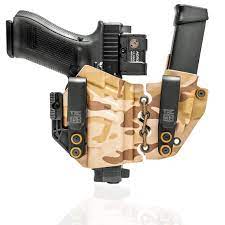In a world where efficiency and quick access to tools is paramount, customizing your gear holster can be a game-changer. Whether you’re a law enforcement officer, a construction worker, or an outdoor enthusiast, a well-organized and tailored gear holster can significantly enhance your performance and ease of operation. Here we will discuss various methods to customize your gear holster, focusing on functionality, comfort, and accessibility.
Understanding Your Needs
The first step in customizing your gear holster is understanding your specific needs. This involves assessing the tools or equipment you need to carry regularly. For instance, a police officer might need a holster for a firearm, handcuffs, and a radio, while a photographer might need quick access to different lenses. Listing down the items you need to carry will help you determine the size, number of compartments, and type of holster that best suits your requirements.
Selecting the Right Material
Material selection is crucial for both durability and comfort. Leather, nylon, and Kydex are popular choices, each with its benefits. Leather, known for its durability and classic appearance, molds to the shape of your gear over time. Nylon is lightweight and weather-resistant, ideal for outdoor use. Kydex, a type of plastic, is highly customizable, durable, and maintains its shape, providing quick and easy access to gear. For those in search of a high-quality, customizable option, the Alien gear holster range at Palmetto State Armory offers a variety of materials and designs to suit any professional or recreational need.
Customizing the Layout
The layout of your holster should reflect the frequency and urgency of accessing each item. Place the most used items in the most accessible spots. For example, if you’re right-handed and your primary tool is a flashlight, position it on the right side of the holster for easy draw. Consider using adjustable or removable compartments to accommodate different sizes of equipment and to provide flexibility in arranging your gear.
Weight Distribution and Comfort
Proper weight distribution is critical for comfort, especially if you wear your holster for extended periods. An unevenly loaded holster can cause discomfort or even injury. Ensure that the weight is evenly distributed across your belt or vest. Padding can also be added to areas that come in direct contact with the body for additional comfort.
Accessibility and Retention
Your gear should be easily accessible yet securely retained in the holster. Custom retention systems such as adjustable straps, snap buttons, or magnetic closures can provide quick access while keeping your equipment secure. For critical tools like a firearm or a medical kit, consider using a retention system that offers both security and rapid access.
Testing and Iteration
Once you’ve customized your holster, it’s essential to test it in the field. This practical experience may highlight adjustments that need to be made for optimal efficiency. Be prepared to iterate on your design based on these real-world experiences.
Maintenance and Upkeep
Finally, maintaining your customized gear holster is essential for ensuring its longevity and performance. Regular cleaning, conditioning (especially for leather), and checking for wear and tear will help your holster stay in top condition.
Conclusion:
Customizing your gear holster is not just about personalization; it’s about creating a system that enhances your efficiency and effectiveness in your professional or recreational activities. By understanding your needs, selecting the right materials, optimizing the layout, and focusing on comfort and accessibility, you can create a holster that meets your unique requirements and improves your performance. Remember, a well-customized holster is an investment in your productivity and safety.

